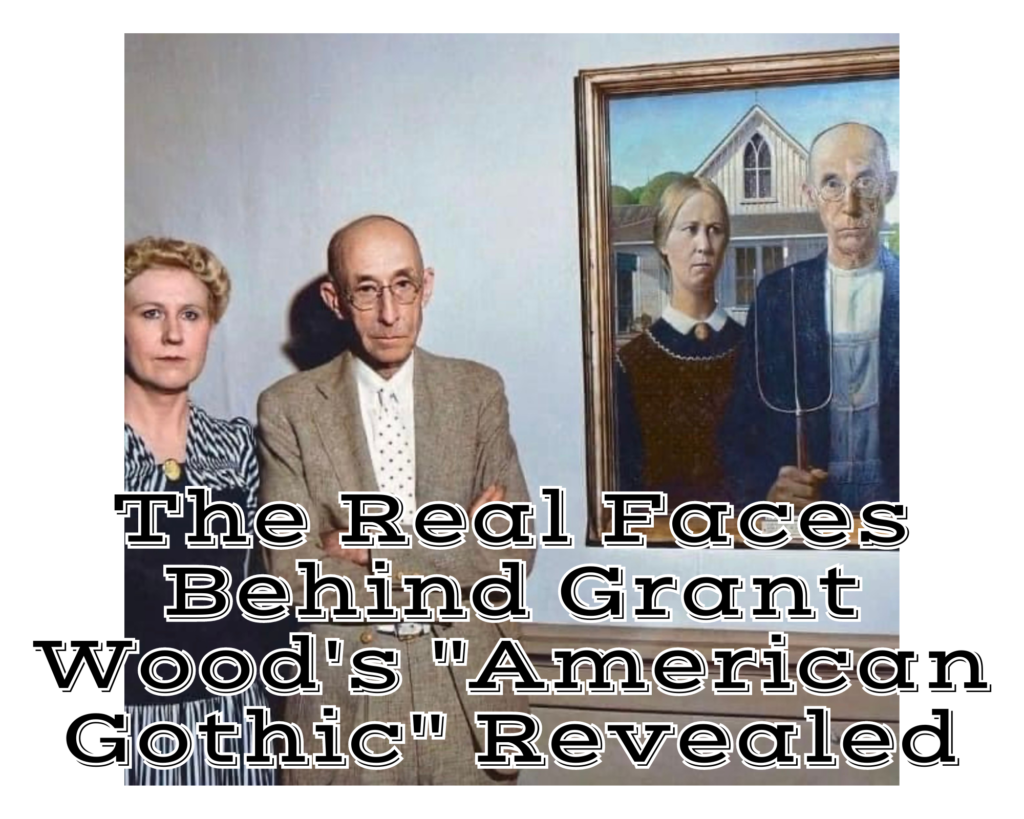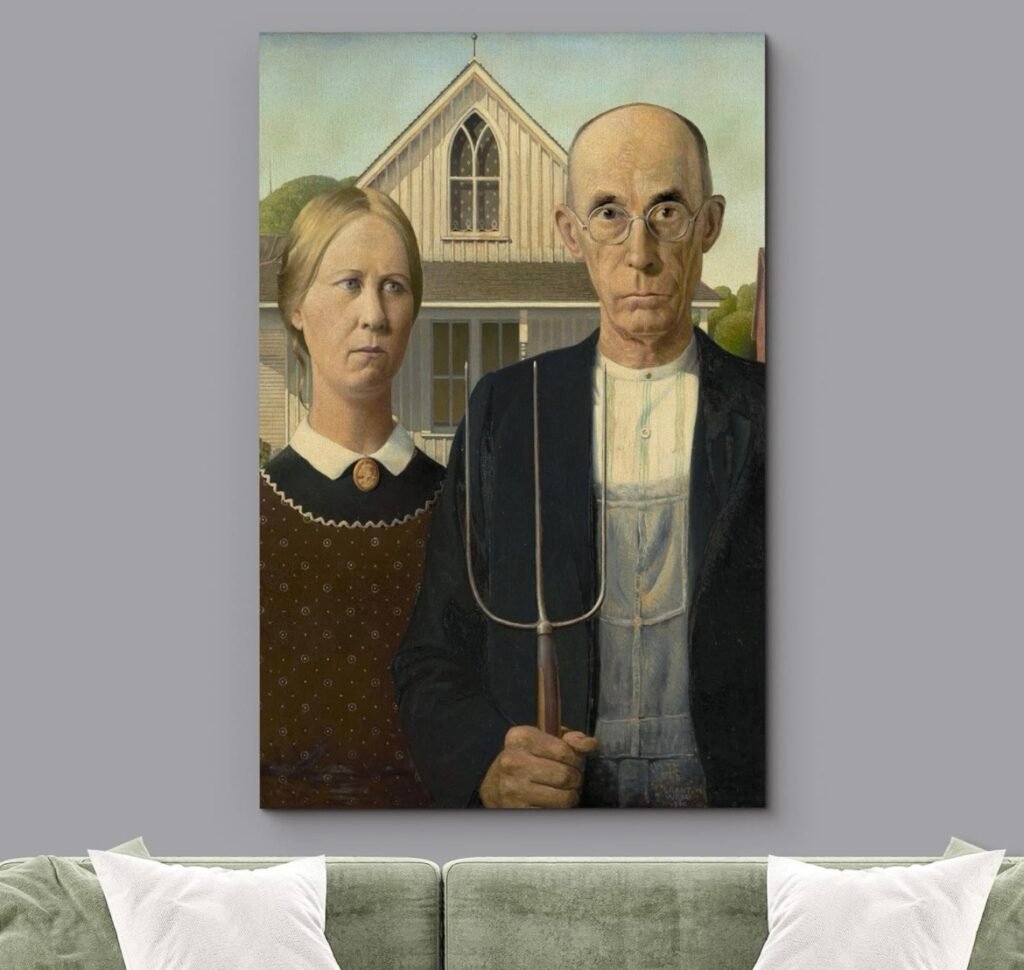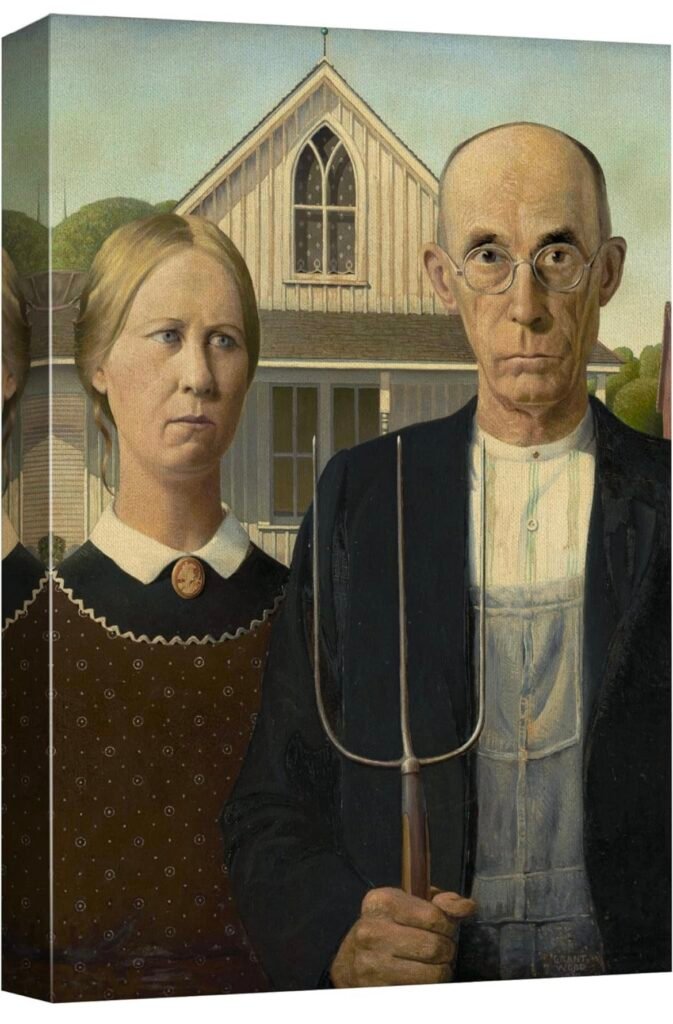You’ve probably seen the iconic 1930 painting “American Gothic” by Grant Wood – the stern farmer clutching a pitchfork beside his equally stoic daughter. But did you know that many people mistakenly assume the woman is his wife? This masterpiece is more than just a depiction of rural American life; it’s a painting filled with intriguing secrets and unexpected choices.
The painting is named after the house in the background, designed in a style known as Carpenter Gothic. However, the real story lies in the faces staring back at you. The farmer and his daughter were actually modeled by two surprising individuals close to Wood. Let’s dive into the fascinating tale of who they were and why Wood chose them for this legendary piece.

Who Are the Real People in the “American Gothic” Painting?
The two faces in “American Gothic” are not just figments of Grant Wood’s imagination. They belong to real people who were part of his life. The stern farmer was modeled by none other than Dr. Byron McKeeby, Wood’s dentist from Cedar Rapids. Yes, you read that right – the man gripping the pitchfork is a dentist!
Standing beside him is Wood’s sister, Nan Wood Graham. Nan’s solemn expression and old-fashioned attire were chosen to reflect the rural Midwestern spirit Wood aimed to capture. The decision to use his sister and dentist adds a personal touch to the painting, making it even more intriguing.
Nan and Dr. McKeeby’s likenesses brought authenticity and relatability to the work. They perfectly embodied the stoic resilience of rural America during the Great Depression, making the painting a powerful representation of the era.
For a look at other fascinating historical figures, you might enjoy The Origins of Coca-Cola: A Refreshing Tale of Innovation.
Why Did Grant Wood Choose His Sister and Dentist?
Grant Wood’s choice of models for “American Gothic” was both practical and personal. When searching for the right faces to represent the quintessential American farmer and his daughter, Wood didn’t look far. His sister Nan and his dentist Dr. Byron McKeeby were readily available and perfectly fit the vision he had for the painting.
Wood wanted to capture the essence of Midwestern perseverance and simplicity. His sister Nan, with her composed and sturdy demeanor, represented the kind of resilient women who kept households running during tough times. Nan’s appearance was easily adaptable to the period attire Wood had in mind, making her an ideal model.
Dr. Byron McKeeby, on the other hand, brought an interesting juxtaposition to the painting. His professional, modern-day occupation contrasted sharply with the agrarian character he portrayed. Wood’s selection of McKeeby was likely influenced by the dentist’s strong features and his willingness to pose. Plus, McKeeby’s face had the stern, no-nonsense look that Wood believed epitomized the hardworking American farmer.
This blend of personal connection and the models’ physical traits helped Wood achieve a striking and memorable image that resonated with viewers. For more on how unexpected choices can create something iconic, check out Fueling the Roaring Twenties: New York’s Filling Stations.

The Iconic House in the Background: What Does It Represent?
One of the most striking features of “American Gothic” is the house in the background. This isn’t just any house; it’s a small white cottage designed in the Carpenter Gothic architectural style. Its distinctive arched window and pointed gables give the painting its name and serve as a perfect backdrop to the rural characters.
The house is located in Eldon, Iowa, and was chosen by Grant Wood for its unique design that contrasted with the simplicity of the American Midwest. Wood saw this house as a symbol of hardworking American values mixed with a touch of European influence. The Gothic elements lent a sense of permanence and durability, reflecting the resilience of the people Wood aimed to depict.
The house’s design added a layer of depth to the painting, making it not just about the people but also about the environment they lived in. It underscored the blend of practicality and aspiration that characterized rural American life during the Great Depression. The house’s prominence in the painting makes it a character in its own right, adding to the story Wood wanted to tell.
For a fascinating look at how infrastructure and architecture shaped another era, consider reading Fueling the Roaring Twenties: New York’s Filling Stations.
Public Reaction to “American Gothic”: What Did People Think?
When “American Gothic” was first displayed at the Art Institute of Chicago in 1930, it stirred up a wide range of reactions. The painting won a bronze medal and a cash prize of $300, establishing Grant Wood as a prominent figure in American art. However, the public and critics had mixed feelings about it.
Some people viewed the painting as a celebration of the American spirit, highlighting the strength and stoicism of rural life. They saw the farmer and his daughter as symbols of resilience and hard work during the tough times of the Great Depression. The detailed realism and stark expressions resonated with many who saw their own lives reflected in the piece.
On the other hand, some critics and viewers interpreted the painting as a satire of rural America. They believed Wood was mocking the simple, provincial lifestyle with the exaggerated seriousness of the characters. This interpretation led to some controversy, especially among Iowans who were not pleased with how they felt their way of life was being portrayed.
Despite the mixed reactions, “American Gothic” quickly became one of the most recognizable and parodied artworks in American culture. Its ambiguity—whether it’s a tribute or a critique—has kept it relevant and intriguing over the decades.
For an example of how public reaction to significant events can shape history, take a look at The Epic Tale of the 1978 Blizzard.

The Legacy of “American Gothic”: Why Is It So Influential?
“American Gothic” has cemented its place as a cornerstone of American art and culture. The painting’s legacy stretches far beyond its initial reception in 1930. It has become an enduring symbol of Americana, capturing the essence of rural life and the complex emotions of the Great Depression era.
The influence of “American Gothic” can be seen in various forms of media and popular culture. It has been parodied countless times, appearing in everything from advertisements to cartoons, often with humorous twists. This widespread recognition has helped keep the painting in the public eye, ensuring its continued relevance.
Art historians and critics often discuss “American Gothic” for its technical excellence and its ability to provoke thought and discussion. Grant Wood’s use of sharp lines, detailed realism, and symbolic elements creates a powerful narrative that invites viewers to look deeper. The painting’s dual interpretations—as both a tribute and a satire—add layers of complexity that continue to fascinate audiences.
Moreover, “American Gothic” has inspired other artists and movements. It played a significant role in the Regionalism art movement, which focused on depicting realistic scenes of rural and small-town America. This movement sought to counter the urban-centric trends in art, emphasizing the unique character and values of the American heartland.
For a deeper dive into how iconic figures have left lasting legacies, you might enjoy reading about Babe Ruth’s Last Stand: The Legend’s Farewell at Yankee Stadium.
Nan Wood Graham and Dr. Byron McKeeby: What Did They Think?
The models behind the stern faces in “American Gothic” had their own unique perspectives on being immortalized in one of America’s most famous paintings. Nan Wood Graham, Grant Wood’s sister, and Dr. Byron McKeeby, his dentist, brought their own reactions and stories to the legacy of the painting.
Nan Wood Graham
Nan was not just a model for her brother; she was a supporter and promoter of his work throughout her life. She embraced her role in “American Gothic” with pride and often spoke about it in public lectures and interviews. Nan’s likeness in the painting symbolized the strong, resilient women of the Midwest, a portrayal she seemed to cherish.
Nan actively participated in preserving her brother’s legacy, making numerous appearances and sharing stories about the creation of “American Gothic.” Her deep connection to Grant Wood’s work provided her with a sense of fulfillment and pride, despite any initial misconceptions about her portrayal.
Dr. Byron McKeeby
Dr. Byron McKeeby, on the other hand, had a more understated reaction to his role in the painting. As a professional dentist, his involvement in art was unexpected and brought a unique twist to his otherwise conventional life. McKeeby reportedly found the experience amusing and took pride in his contribution to the painting’s success.
While McKeeby did not seek the spotlight as actively as Nan, he appreciated the painting’s fame and his unusual claim to it. His serious expression in the painting, contrasted with his everyday role as a dentist, added to the intrigue and discussion surrounding the work.
Both Nan and Dr. McKeeby’s willingness to pose for Grant Wood not only helped create an iconic piece of art but also provided personal anecdotes that enrich the painting’s history.
For another glimpse into historical figures and their unexpected roles, explore the story of The Birger Gang: Southern Illinois Bootleggers 1924.
The Enduring Fascination with “American Gothic”
“American Gothic” continues to captivate and intrigue audiences nearly a century after its creation. The painting’s enduring appeal lies in its ability to evoke curiosity and provoke thought. Whether viewers see it as a tribute to the hardworking spirit of rural America or a subtle satire of provincial life, “American Gothic” sparks discussion and reflection.
The true identities of the models—Nan Wood Graham and Dr. Byron McKeeby—add an additional layer of interest. Knowing that Grant Wood chose his sister and his dentist for this iconic work brings a personal touch that deepens our appreciation for the painting. Their unique contributions helped shape a piece that would become a symbol of American resilience and character.
The painting’s impact on American art and culture is undeniable. It has inspired countless parodies, appeared in various media, and influenced the Regionalism art movement. “American Gothic” remains relevant, reminding us of the complexity and richness of American life during the Great Depression.
Understanding the story behind “American Gothic” enhances our appreciation of Grant Wood’s masterpiece. The next time you see the stern farmer and his daughter, you’ll know the fascinating story of the faces behind the painting and the cultural significance they embody.
For those interested in owning a piece of this iconic art, consider American Gothic by Grant Wood Giclee Canvas Prints Wrapped Gallery Wall Art | Stretched and Framed Ready to Hang – 16″ x 24″ for a beautifully detailed reproduction.
Thank you for joining this exploration of one of America’s most famous paintings. If you enjoyed learning about the faces behind “American Gothic,” you might also like discovering more historical stories, such as The Origins of Coca-Cola: A Refreshing Tale of Innovation.
As an Amazon Associate we earn from qualifying purchases through some links in our articles.




